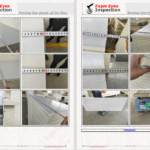
Introduction to Defect Sorting Service
When you’re responsible for delivering products that meet strict quality standards, even a small percentage of defects can have a big impact—on your brand, your bottom line, and your customer relationships. Sounds complex? That’s where a Defect Sorting Service steps in, serving as a crucial safeguard in modern manufacturing and supply chains.
What is a Defect Sorting Service?
At its core, a Defect Sorting Service is a focused quality control process designed to identify, segregate, and remove non-conforming or defective products from a batch before they reach the next stage of the supply chain or the end customer. Unlike general inspections that assess a broad range of potential issues, this service zeroes in on specific, known defects—such as issues with appearance, functionality, safety, workmanship, or color—that have already been flagged during previous inspections or quality checks.
- Defect sorting service example: Imagine a shipment of electronic devices where a failed inspection revealed a recurring problem with battery installation. A defect sorting team would then focus exclusively on checking and removing units with this issue, ensuring only compliant products move forward.
Why is Defect Sorting Service Essential?
In today’s competitive market, businesses can’t afford to let defective goods slip through. A single batch of flawed products can result in costly returns, damaged brand reputation, or even safety recalls. By targeting and removing these non-conforming items, defect sorting helps:
- Provide transparency about the percentage and types of defects present in a shipment
- Enable informed decisions—such as whether to accept, rework, or reject a batch
- Ensure that only products meeting your standards reach distribution or retail shelves
Who Benefits from Defect Sorting Service?
This service is invaluable for:
- Manufacturers aiming to uphold strict quality benchmarks
- Importers and exporters who need assurance before accepting shipments
- Retailers committed to protecting their brand and customer satisfaction
Ultimately, Defect Sorting Service acts as a targeted, efficient solution for quality-focused organizations, helping you catch problems before they escalate and reinforcing your commitment to excellence.

The Critical Role of Defect Sorting in Comprehensive Quality Control
Imagine you’re preparing to ship a large batch of products—everything looks fine at first glance, but what if a handful of defective items are hidden in the mix? That’s where defect sorting inspection becomes a game-changer in the quality control process. Rather than relying solely on random sampling or spot checks, quality control defect sorting offers a meticulous, all-encompassing approach to identifying and removing every non-conforming product before it leaves the factory floor.
Why Defect Sorting Is a Cornerstone of Quality Assurance
When you integrate defect sorting inspection into your broader quality assurance framework, you’re taking a proactive stance against costly mistakes. This process doesn’t just catch the occasional faulty item—it systematically safeguards your brand, your customers, and your reputation. Here’s how defect sorting fits into a robust quality control system:
- Comprehensive Coverage: Every single unit is checked, not just a sample, ensuring no defective item slips through unnoticed.
- Customizable Criteria: Sorting can be tailored to focus on specific known issues, whether they’re visual flaws, functional errors, or safety concerns.
- Actionable Insights: The process generates detailed reports, giving you clear evidence for vendor negotiations and helping you pinpoint root causes for future prevention.
Indeed, a robust quality assurance framework often combines Defect Sorting Service with other critical checkpoints, like a final Pre-Shipment Inspection, to achieve comprehensive coverage and peace of mind.
The Hidden Costs of Unchecked Defects
What happens if defects go undetected? The consequences can be far-reaching and severe. Consider the following negative impacts of skipping or underutilizing quality control defect sorting:
- Compromised Safety: Defective products can pose real safety risks to end-users, leading to recalls and legal liabilities.
- Increased Returns and Complaints: More defective goods in the marketplace mean higher return rates, customer dissatisfaction, and mounting support costs.
- Brand Reputation Damage: Negative word-of-mouth and online reviews can quickly erode trust in your brand, making it harder to win new business or retain loyal customers.
- Regulatory and Compliance Issues: Non-conforming products may violate safety or industry regulations, exposing your business to fines or legal action.
- Operational Inefficiency: Handling complaints, processing returns, and managing recalls diverts resources from core business activities.
By integrating defect sorting inspection into your quality control strategy, you’re not just ticking a box—you’re actively protecting your business from these risks and building a reputation for reliability.
As you continue exploring the intricacies of quality control, the next section will walk you through the step-by-step process of how defect sorting services are executed, demystifying what happens behind the scenes and why each stage matters.
Unpacking the Defect Sorting Service Process
When you hear about a defect sorting process, you might wonder—what really happens behind the scenes to ensure only top-quality products reach your customers? Imagine standing on the factory floor, watching as each individual item is checked, sorted, and recorded. The process is thorough, systematic, and designed to leave nothing to chance. Here’s how a typical defect sorting inspection service unfolds, step by step.
1. Initial Consultation & Defining Criteria
Every successful sorting project starts with a clear understanding. The service provider consults with you and your supplier to review product specifications, order details, and—most critically—what counts as a defect. This step ensures everyone is aligned on expectations and standards. Sorting criteria are customized to your needs, whether you’re concerned about cosmetic flaws, functional issues, or packaging imperfections.
2. Preparation & On-Site Setup
Next, a dedicated sorting area is established at the production site. The inspection team prepares quality control protocols, briefings, and checklists tailored to your product and defect types. This groundwork ensures that inspectors know exactly what to look for and how to classify each issue. Think of this as setting the rules of the game, so nothing is left to interpretation.
3. Comprehensive Inspection & Sorting
This is where the action happens. Each product is individually examined—no random sampling here. Inspectors use visual checks for appearance flaws (like scratches or discoloration), functional tests for performance, and workmanship checks for assembly errors. As they work, they:
- Segregate non-conforming products from those that meet your standards
- Classify defects as minor, major, or critical for detailed analysis
- Provide on-the-spot feedback to suppliers, helping address recurring issues immediately
The goal? To ensure only compliant products move forward, while defective items are set aside for rework, repair, or disposal—based on your instructions.
4. Real-Time Feedback & Daily Reporting
Transparency is key. Throughout the defect sorting inspection service, inspectors provide daily updates or real-time feedback. This means you’re always in the loop about progress, defect rates, and any emerging trends. If a pattern of defects is discovered, you can make quick decisions—such as halting shipment or requesting corrective action.
5. Detailed Reporting & Documentation
Once sorting is complete, you’ll receive a comprehensive report—often within 24 hours. This includes:
- Photos and descriptions of each defect type
- Quantitative results (how many units inspected, how many defects found)
- Defect classification breakdown (minor, major, critical)
- Actionable recommendations for next steps
This documentation empowers you to negotiate with suppliers, make informed shipment decisions, and improve future production runs.
6. Handling of Defective Products
What happens to the products that don’t make the cut? Defective items are separated and handled according to your instructions—whether that means rework, repair, or disposal. This final step closes the loop, ensuring that only products meeting your standards enter the next phase of the supply chain.
| Step | Key Actions |
|---|---|
| 1. Consultation | Define defect criteria, align on expectations |
| 2. Preparation | Set up site, brief inspectors, prep checklists |
| 3. Inspection & Sorting | Check each item, segregate defects, classify issues |
| 4. Feedback & Reporting | Provide on-site updates, deliver daily summaries |
| 5. Documentation | Issue full reports with photos and analysis |
| 6. Defective Product Handling | Separate, rework, or dispose as instructed |
By following this methodical approach, the defect sorting process transforms quality control from a guessing game into a transparent, data-driven operation. Next, let’s explore why outsourcing these tasks to specialized providers can elevate your quality assurance strategy even further.

Key Benefits of Outsourcing Your Defect Sorting Needs
When you’re faced with a sudden spike in defects or an urgent shipment deadline, do you wonder if handling everything in-house is really the best use of your time and resources? Imagine freeing up your team to focus on what they do best, while seasoned professionals handle the meticulous task of defect sorting. That’s the promise—and the practical advantage—of outsourcing defect sorting to a dedicated defect sorting service provider.
Why Consider Outsourcing Defect Sorting?
Sorting through thousands of products to catch every non-conforming unit is no small feat. Building this capability internally can be costly, time-consuming, and distracting. By partnering with an experienced third-party, you tap into a proven system that brings expertise, technology, and efficiency right to your production line. Here’s what you gain:
- Access to Expert Inspectors and Advanced Equipment: Specialized providers employ highly trained quality inspectors equipped with precision tools and cutting-edge technology. Their expertise ensures that even subtle or complex defects are detected and handled with accuracy.
- Increased Objectivity and Impartiality: Third-party teams are independent from your internal staff and suppliers, providing unbiased assessments. This objectivity is crucial for building trust with customers and stakeholders, as impartial inspectors are less likely to overlook issues due to familiarity or internal pressures.
- Scalability and Flexibility: Outsourcing gives you the ability to quickly ramp up or down based on demand. Whether you’re dealing with a large, urgent order or a recurring need, service providers can adjust their resources to match your requirements—without the headache of hiring, training, or managing additional staff.
- Reduced Internal Costs: Setting up an in-house defect sorting operation involves significant investment in equipment, staffing, training, and ongoing maintenance. Outsourcing eliminates these fixed costs, allowing you to pay only for what you need, when you need it.
- Faster Turnaround and Responsiveness: Leading providers are structured to mobilize quickly, often offering rapid response times and 24/7 availability. This agility helps you meet tight deadlines, avoid costly production delays, and maintain your commitments to customers.
- Focus on Core Business Activities: By delegating defect sorting, your internal teams can concentrate on product development, customer service, and strategic growth—rather than getting bogged down by repetitive inspection tasks.
- Access to Technology and Innovation: Many providers continually invest in the latest inspection technology and process innovations, giving you a competitive edge without capital expenditure.
What Sets a Specialized Provider Apart?
Not all providers are created equal. Services like Eagle Eyes Quality Inspection stand out by offering a dedicated Defects Sorting Service designed for thoroughness and speed. Their approach features 100% on-site inspection, tailored checklists based on your unique requirements, and a team of experienced inspectors who focus exclusively on the defects that matter most to your business. This targeted, methodical approach ensures that only compliant, high-quality products move forward—minimizing returns, protecting your reputation, and supporting regulatory compliance.
“When you outsource defect sorting, you’re not just buying a service—you’re investing in peace of mind, operational efficiency, and the freedom to focus on what truly drives your business forward.”
Ready to take your quality control to the next level? In the next section, we’ll guide you through what to look for when choosing the right defect sorting service provider, so you can make a confident, informed decision.
How to Choose Defect Sorting Service Providers
When you’re faced with a batch of products that could make or break your brand’s reputation, choosing the right defect sorting partner isn’t just a box to tick—it’s a strategic decision. Sounds complex? It doesn’t have to be. By focusing on a few essential factors, you’ll notice that the process of how to choose defect sorting service providers becomes much more straightforward, allowing you to compare options with confidence and clarity.
Key Factors to Consider When Selecting a Defect Sorting Service
Imagine you’re evaluating several providers. What should you look for? Here are the criteria that matter most, drawn from industry best practices and real-world experience:
- Industry Experience and Track Record: Has the provider handled sorting for your specific product type or industry? Proven expertise translates into fewer errors and more reliable results.
- Technical Capabilities and Range of Techniques: Does the company use advanced equipment like optical sorters, vision systems, or automated inspection tools? A broad toolkit means they can tackle both simple and complex defect types.
- Customizable Solutions: Can the provider tailor their approach to your unique requirements, or do they offer one-size-fits-all services?
- Quality Assurance Protocols: Are there robust checks, audits, and data tracking in place to ensure consistent results?
- Certifications and Compliance: Look for ISO or industry-specific certifications that demonstrate commitment to quality and regulatory standards (ThomasNet).
- Reporting and Transparency: Will you receive detailed reports with photos, defect counts, and actionable insights?
- Client Feedback and References: What do past clients say about their experience? Reliable providers should be able to share testimonials or case studies.
- Responsiveness and Communication: Is the team easy to reach, proactive in updates, and clear in their communication?
- Scalability and Flexibility: Can the provider ramp up quickly for urgent or large-scale projects?
- Pricing Structure: Are their quotes transparent, with no hidden fees? Do they explain what’s included?
Defect Sorting Service Comparison Table: Questions to Ask Providers
To help you make a well-informed decision, use the table below as a practical checklist when comparing potential partners. For illustration, we’ve included Eagle Eyes Quality Inspection, a specialized provider known for its thorough, client-focused approach.
| Key Question | Why It Matters | What to Look for (Eagle Eyes Example) |
|---|---|---|
| How much experience do you have in my industry? | Ensures familiarity with product-specific challenges. | Years of experience with electronics, apparel, automotive, and more. |
| What inspection technologies do you use? | Determines ability to detect various defect types efficiently. | Equipped with advanced vision systems and manual expertise for 100% inspection. |
| Can you customize your sorting criteria to my needs? | Customization ensures your unique standards are met. | Client-provided checklists and tailored defect criteria built into every project. |
| Are you certified (e.g., ISO 9001)? | Certifications demonstrate a commitment to quality and compliance. | Holds relevant industry certifications for quality assurance. |
| How detailed are your reports? | Detailed reports support transparency and decision-making. | Comprehensive daily and final reports with photos, defect breakdowns, and actionable insights. |
| What do your clients say about your service? | Testimonials and references reveal service quality and reliability. | Strong client feedback and published case studies available upon request. |
| How quickly can you respond to urgent needs? | Responsiveness is crucial for time-sensitive shipments. | Rapid mobilization and flexible scheduling, even for last-minute projects. |
| How is your pricing structured? | Clear pricing avoids surprises and supports budgeting. | Transparent, itemized quotes with explanations of all included services. |
By systematically comparing providers using these questions, you’ll find it easier to identify the right fit—one that aligns with your operational needs, quality expectations, and business goals. A specialized partner like Eagle Eyes Quality Inspection stands out by offering tailored, technology-driven solutions, robust reporting, and a proven track record across multiple industries.
Next, let’s take a closer look at how the financial aspects of defect sorting services stack up, and why investing in the right partner can be a cost-effective strategy for your business.
Understanding the Cost-Effectiveness of Defect Sorting Services
When you weigh the cost of defect sorting service against the risks and expenses of letting defects slip through, the financial logic quickly becomes clear. Have you ever faced a costly product recall or lost a major client due to a preventable quality issue? If so, you know that the real price of defects goes far beyond the initial inspection fee. Let’s break down why investing in professional defect sorting is not just a quality measure—it’s a smart business decision with measurable returns.
Direct Costs vs. Hidden Liabilities: What’s Really at Stake?
At first glance, defect sorting might seem like an added expense. But look closer, and you’ll notice that the direct cost of sorting—whether for labor, automation, or third-party services—is often dwarfed by the indirect costs of unchecked defects. Here’s what’s on the line if defects go undetected:
- Product Recalls and Returns: Handling returns or issuing recalls can incur massive costs, from logistics to replacement and customer compensation.
- Warranty Claims: Defective products in the field result in expensive warranty repairs, replacements, and administrative headaches.
- Brand Reputation Damage: News of defective products spreads fast, eroding trust and potentially leading to lost contracts or market share.
- Regulatory Penalties: Non-conforming goods may trigger fines or legal actions, especially in highly regulated industries.
- Operational Disruption: Addressing quality failures diverts resources, delays shipments, and can even halt production lines.
According to industry studies, even a modest improvement in defect detection can yield significant savings. For example, automated inspection systems have helped manufacturers save millions annually by reducing false positives and minimizing labor costs, while also boosting yield and throughput.
How Efficient Defect Sorting Minimizes Waste and Rework
Imagine a production line where every defective unit is caught before it ships. Efficient defect sorting not only prevents customer-facing issues but also:
- Reduces scrap and unnecessary waste by identifying reworkable units early
- Lowers re-inspection and manual review costs by automating or standardizing the process
- Improves overall process yield, translating to higher revenue per batch
For example, in agricultural packing, implementing automated defect sorting technology can lead to substantial labor savings and fast payback periods—sometimes less than three years if four or more workers are replaced—making the investment highly cost-effective (Lu et al., 2023).
Calculating the ROI of Defect Sorting
So, what’s the defect sorting ROI? The return on investment comes from a combination of direct cost savings and avoided losses. Consider the following:
- Labor savings from automation or streamlined manual processes
- Reduced costs from fewer returns, recalls, and warranty claims
- Increased throughput and yield, leading to higher sales and revenue
- Protection of brand value, helping secure future business
In real-world scenarios, manufacturers have reported annual savings ranging from hundreds of thousands to millions of dollars after switching to automated or high-efficiency defect sorting systems. For instance, one case study highlighted an $18 million annual saving per line in medical equipment manufacturing by reducing false rejects and improving accuracy. Similarly, agricultural producers saw positive net present value (NPV) and payback periods of less than three years when replacing manual sorting with automated systems (Lu et al., 2023).
What Influences the Cost of Defect Sorting Service?
Several factors determine what you’ll pay for defect sorting:
- Volume: Higher quantities may qualify for bulk pricing or require more advanced automation.
- Complexity: Products with intricate features or multiple defect types may need specialized equipment or expertise.
- Location: On-site sorting, remote operations, and logistics all affect pricing.
- Technology Used: Manual inspection is labor-intensive, while automated systems have higher upfront costs but deliver long-term savings.
- Reporting and Compliance Needs: Detailed documentation, regulatory requirements, or client-specific reporting can add to service costs.
Ultimately, the most cost-effective approach is one that balances up-front investment with long-term savings, risk mitigation, and process improvement. By understanding the full financial picture, you can make informed decisions that protect your business and maximize quality.
As you consider the financial impact, remember that the benefits of defect sorting extend beyond the balance sheet—directly influencing your brand’s reputation and customer satisfaction. Next, we’ll explore how effective defect sorting builds trust and loyalty in the marketplace.

Enhancing Brand Reputation and Customer Satisfaction through Defect Sorting
Ever wondered why some brands seem to have loyal customers who keep coming back, while others struggle with negative reviews and high return rates? The answer often lies in how well they manage product quality before anything reaches the customer. Let’s break down the direct connection between defect sorting and customer satisfaction—and why getting it right can transform your brand’s reputation for the better.
How Defect Sorting Drives Customer Loyalty and Trust
Imagine you’ve just purchased a product. You expect it to work perfectly, look great, and be exactly what was promised. If it doesn’t, disappointment sets in—and you might not give that brand a second chance. Effective defect sorting services act as a crucial filter, ensuring only conforming products reach your customers. Here’s how this process directly impacts satisfaction and loyalty:
- Reduces Customer Complaints and Returns: By systematically removing defective items, you dramatically lower the chances of customers receiving faulty goods. This means fewer complaints, less hassle with returns, and a smoother experience for everyone involved.
- Builds Reliability and Consistency: Consistent quality creates a sense of trust. When customers know they can count on your products to meet expectations every time, they’re more likely to become repeat buyers and recommend your brand to others (PLI Sorting).
- Encourages Positive Word-of-Mouth: Satisfied customers share their experiences—both online and in person. Positive reviews and recommendations help you win new business and reinforce your reputation in the market.
- Minimizes Brand-Damaging Events: Proactive defect sorting helps avoid large-scale recalls, negative press, and viral complaints that can quickly erode years of brand-building efforts (NuShoe Inspect & Correct).
- Supports a Premium Brand Image: When your products consistently meet or exceed expectations, you position your brand as reliable and high-quality—making it easier to command premium pricing and customer loyalty.
Real-World Impact: From Prevention to Promotion
Let’s put this into perspective. According to industry insights, businesses that prioritize thorough inspection and sorting see a noticeable drop in after-sales problems, including complaints and costly returns. This not only saves money but also frees up your team to focus on growth, innovation, and customer engagement.
But the benefits don’t stop at prevention. When customers consistently receive quality products, they become advocates for your brand. Over time, this cycle of reliability and positive feedback builds a reputation that attracts new customers and secures long-term success—a true win-win for both your business and your buyers.
As you can see, the value of defect sorting extends well beyond the factory floor. In the next section, we’ll summarize why implementing a robust defect sorting service is a strategic investment in your brand’s future growth and operational excellence.
Conclusion
When you step back and look at the bigger picture, what makes a business truly stand out in today’s competitive marketplace? It’s not just about delivering products—it’s about delivering consistent quality, minimizing risks, and building a brand customers trust. That’s where the defect sorting service benefits really shine.
Why Implement Defect Sorting? Key Takeaways
Imagine a scenario where every batch you ship is free from known defects, your return rates drop, and customer complaints become rare exceptions. Sounds ideal? That’s the practical result of investing in a robust defect sorting process. Here’s why quality-focused businesses increasingly view this as a strategic must-have:
- Risk Mitigation: By catching and removing non-conforming products before they reach customers, you avoid costly recalls, warranty claims, and potential compliance violations (Shakebugs).
- Brand Protection: Consistent quality means fewer negative reviews and stronger word-of-mouth, safeguarding the reputation you’ve worked hard to build.
- Operational Excellence: Streamlined sorting processes reduce rework, minimize waste, and free up your team to focus on innovation and growth.
- Customer Loyalty: When customers receive reliable, defect-free products, satisfaction rises and loyalty follows—fueling repeat business and referrals.
- Data-Driven Improvement: Detailed defect reports help you pinpoint root causes, enabling continuous process improvements and smarter supplier management.
Quality Improvement through Defect Sorting: A Smart Investment
Still wondering if defect sorting is worth it? Consider this: early defect resolution not only saves money but also prevents small issues from becoming major headaches down the line. Proactive sorting is a cornerstone of quality improvement defect sorting strategies, ensuring that your products consistently meet or exceed expectations (Shakebugs).
And you don’t have to go it alone. Partnering with a specialized provider like Eagle Eyes Quality Inspection gives you access to expert inspectors, advanced methodologies, and tailored solutions that deliver peace of mind and superior results. Their approach—meticulous, transparent, and client-focused—means you can trust every shipment to reflect your brand’s commitment to excellence.
“Defect sorting isn’t just about catching problems—it’s about building a foundation for sustainable growth, customer trust, and operational success.”
As you look ahead, consider defect sorting not as a cost, but as a proactive investment in your business’s future. By taking quality seriously now, you set the stage for fewer risks, stronger brand value, and long-term competitive advantage. Ready to unlock superior quality and peace of mind? The right partner can help you get there—one sorted batch at a time.
Frequently Asked Questions about Defect Sorting Service
1. What is a Defect Sorting Service and why is it important?
A Defect Sorting Service is a targeted quality control process that identifies and removes non-conforming products from a batch before they reach customers. This service is crucial for manufacturers, importers, and retailers to prevent defective goods from entering the market, reduce costly returns, and protect brand reputation.
2. What are the main types of product defects addressed in sorting?
Product defects are typically classified as minor, major, or critical. Minor defects may not affect product use, major defects can impact functionality or appearance, and critical defects pose safety risks. Defect Sorting Services focus on identifying and segregating all these types to ensure only compliant items proceed.
3. How does the defect sorting process work?
The defect sorting process involves several key steps: defining defect criteria, preparing on-site inspection protocols, individually checking each product, segregating defective units, providing real-time feedback, and delivering detailed reports. This systematic approach ensures thorough quality control and data-driven decision-making.
4. What are the benefits of outsourcing defect sorting to a third-party provider?
Outsourcing defect sorting gives you access to expert inspectors, advanced equipment, and flexible resources. It increases objectivity, reduces internal costs, speeds up turnaround, and allows your team to focus on core operations. Providers like Eagle Eyes Quality Inspection offer tailored solutions for rapid, precise sorting.
5. How can defect sorting services improve customer satisfaction and brand reputation?
By removing defective products before they reach the market, defect sorting minimizes customer complaints and returns. Consistent quality builds trust and loyalty, encourages positive reviews, and helps maintain a strong, reliable brand image over time.



